 |
PO Box 9021,
Wilmington, DE 19809, USA
E-mail: font@focusonnature.com
Phone: Toll-free in USA 1-888-721-3555
or 302/529-1876 |
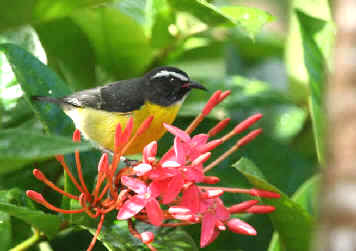
Caribbean Birds
in the West Indies
Trogons to Buntings
Noting those found during
Focus On Nature Tours
with an (*)
1990
thru 2015
In Antigua, Barbados, Barbuda, the Cayman Islands, Dominica, the Dominican Republic, Grenada,
Guadeloupe, Haiti, Jamaica, Puerto Rico, Saint Lucia, and Saint Vincent.
During the months of January,
February, March, April, May, July, December.
Also noted in this two-part list are birds in the Bahamas and Cuba.
Upper right photo: a
BANANAQUIT, one of the most characteristic birds of the Caribbean. Photographed
during a FONT tour.
PART 2 of a Caribbean Bird List, with some
photos
compiled by Armas Hill, the
leader of most of the FONT tours on those islands
Link
to Part #1 of this list of West Indies Birds, Guineafowl to Hummingbirds
In the this list (parts 1 & 2), there are 592
species of
birds. 357 have been found during FONT tours in the
Caribbean, with 4 notable subspecies
also noted here.
In the CAYMAN ISLANDS, there have been 6 FONT birding & nature tours since
1999, during which 97 species of birds have cumulatively been
found.
In the DOMINICAN REPUBLIC, during 19 FONT birding & nature tours,
191 species of birds have cumulatively been found.
In JAMAICA, during 10 FONT birding & nature tours, 155
species of birds have cumulatively been found.
In the LESSER ANTILLES, 140 species of birds have cumulatively been found. 3
subspecies brings that list to 143. The Lesser Antillean tours have included 15 in
SAINT LUCIA,
10 in SAINT VINCENT, 7 in DOMINICA, 2 in ANTIGUA, 2 in BARBADOS, 1 in BARBUDA, 1
in GRENADA, and 1 in GUADELOUPE.
In PUERTO RICO, during 27 FONT birding & nature tours, 186 species of birds have cumulatively been found.
Codes:
(i): introduced in the Caribbean, or on the particular island
(or in the particular country)
(t): a globally threatened or rare species, designated by Birdlife International
(t1): critical
(t2): endangered
(t3): vulnerable
(nt): a near-threatened species globally
(e): endemic to the particular island (or
the particular county)
(qe): quasi (or near) endemic
(r): rare on the particular island (or
in the particular country)
(p): seen pelagically (but not exclusively
so)
(mi): on Mona Island, off Puerto Rico
(HIe): endemic to
Hispaniola (Dominican Republic & Haiti)
(LAe): endemic to the Lesser Antilles
(LAe): quasi (or nearly) endemic to the Lesser Antilles
(PR&VIe): endemic to Puerto Rico & the Virgin Islands
(WIr): rare in the West Indies
(ph): species with a photo in the FONT website
In the list that follows, sightings during
FONT tours, noting the Caribbean island or country, and the months when found, are
noted in blue.
Other occurrences, relating to various islands, are
noted in either maroon or black.
AT: Antigua
BD: Barbados
BH:
Bahama Islands
BU:
Barbuda
CU:
Cuba
CY: the Cayman
Islands
DM: Dominica
DR: Dominican
Republic (on Hispaniola)
GD:
Guadeloupe
GR: Granada
HA: Haiti (on
Hispaniola)
JM: Jamaica
MN:
Montserrat
NA:
Netherlands Antilles (Aruba, Bonaire, Curacao)
PR: Puerto
Rico
SL: Saint Lucia
SV: Saint Vincent
Other island codes:
HI: Hispaniola
VI: the Virgin
Islands
Links within this List to Bird Groupings:
Trogons
Kingfishers
Todies Woodpeckers
Flycatchers Vireos
Crows Palmchat
Martins & Swallows Wrens
Thrashers Thrushes
Old World introduced
species
Euphonias Siskins & Crossbill
New World
Warblers Blackbirds,
Orioles & allies
Bananaquit Sparrows, Finches, Seedeater, Grassquits,
Bullfinches Tanagers
Saltator, Grosbeaks, Buntings
Other Links:
Upcoming
FONT Birding and Nature Tours:
in the Caribbean
in
2015 in 2016 by geographic location worldwide
FONT Past Tour
Highlights
Birds-Lists
for: Cayman
Islands Dominican
Republic Jamaica
Lesser
Antilles (St. Lucia, St. Vincent, Dominica, and Guadeloupe)
Puerto Rico
Rare
Birds of the Caribbean today & those that have gone extinct
Other
Lists and Photo Galleries:
Butterflies
of the
Caribbean Moths of the Caribbean
Mammals of the Caribbean (Land & Marine)
Fish of the Caribbean Other Marine Life
(including corals,
jellyfish, mollusks, arthropods)
Amphibians & Reptiles
of the Caribbean (with some photos)
Directory
of Photos in the FONT Website

Bird-List:
TROGONS
- Hispaniolan Trogon (nt) (*) (ph) ______
DR:feb,mar,apr,jul,dec (species
endemic to Hispaniola)
Priotelus (was
Temnotrogon) roseigaster (monotypic)
In the genus Priotelus, there
are only the 2 trogons of the Caribbean, the Hispaniolan Trogon and the
Cuban Trogon (below).
Regarding the HISPANIOLAN TROGON, go to: RARE BIRDS OF THE CARIBBEAN
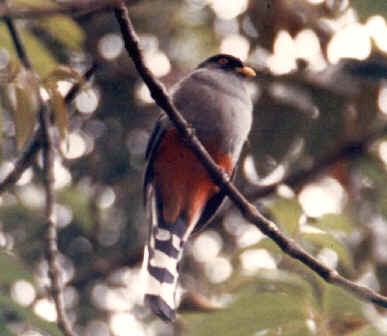
Hispaniolan Trogon, photographed during a FONT tour
- Cuban Trogon ______ CU
(species endemic to Cuba)
Priotelus
(was Temnotrogon) temnurus
The Cuban Trogon is the national bird of Cuba.
KINGFISHERS
- Belted Kingfisher (*) (ph) ______
BH CU CY:feb,dec
DM:jan,mar DR:jan,feb,mar,apr,dec HA:apr JM:mar,apr PR:feb,mar SV
Megaceryle
(formerly Ceryle)
alcyon
(monotypic)
- Ringed Kingfisher (*) (ph) ______ DM:jan,mar
Megaceryle
(formerly Ceryle) torquata stictipennis
(subspecies endemic
to the West Indies, only on Dominica & Guadeloupe)
TODIES
- Narrow-billed Tody (nt) (*)
______ DR:feb,mar,apr,jul,dec (species
endemic
to Hispaniola)
Todus angustirostris (monotypic)
(this genus, with 5 species, endemic to the Caribbean)
- Broad-billed Tody (*) (ph) ______
DR:jan,feb,mar,apr,jul,dec (species endemic to Hispaniola)
Todus subulatus
(monotypic)
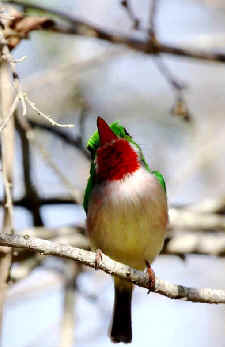
Above & below: Photographs of the
Broad-billed Tody
during the April 2012 FONT tour in the Dominican Republic
(photos by Marie Gardner)
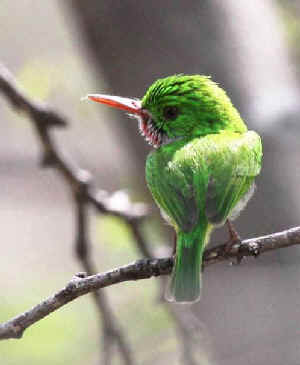
- Jamaican Tody (*) (ph) ______ JM:mar.apr
(species endemic to Jamaica)
Todus todus (monotypic)
A local name for the Jamaican Tody is "Robin
Redbreast".
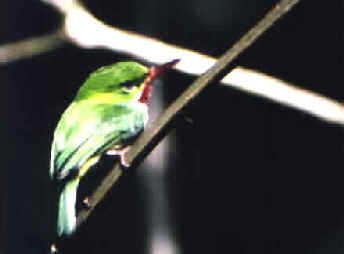
Jamaican Tody, photographed during a FONT tour
- Puerto Rican Tody (*) (ph) ______ PR:feb,mar,apr
(species endemic to Puerto Rico)
Todus mexicanus (monotypic)
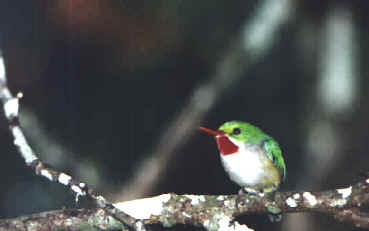
Puerto Rican Tody
- Cuban Tody ______ CU
(species endemic to Cuba)
Todus multicolor
WOODPECKERS
- Antillean
Piculet (nt) (*) ______ DR:jan,feb,mar,apr,jul
(species endemic to Hispaniola)
Nesoctites m. micromegas (another
subspecies on Gonave Island, off DR) (the single member of its genus)
- West Indian Woodpecker (*) ______
BH CU CY:feb,jun,dec
Melanerpes superciliaris
Melanerpes superciliaris blakei (subspecies endemic to the
Bahamas, on Abaco Island)
Melanerpes superciliaris caymanensis (subspecies
endemic to Grand Cayman Island)
Melanerpes superciliaris murceus (subspecies endemic to Cuba,
on Isla de la Juventud)
Melanerpes superciliaris nyeanus (subspecies endemic to the
Bahamas, on Grand Bahama & San Salvador Island)
Melanerpes superciliaris superciliaris (subspecies endemic to
Cuba)
- Hispaniolan Woodpecker (*) (ph) ______ DR:jan,feb,mar,apr,jul,dec
(species endemic to Hispaniola)
Melanerpes striatus (monotypic)
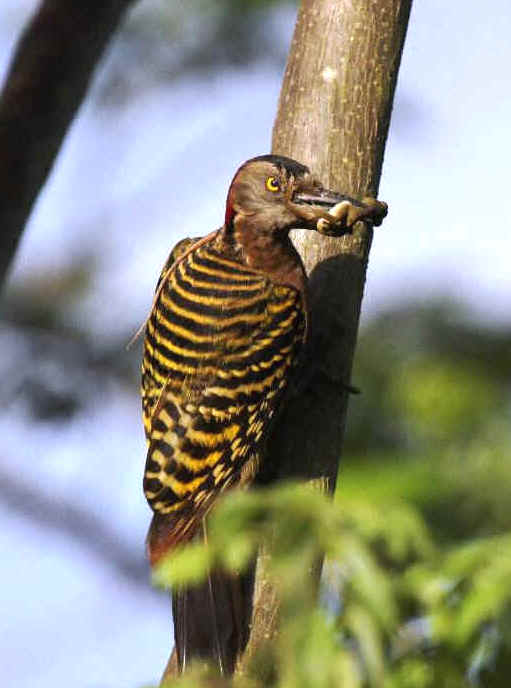
A Hispaniolan Woodpecker photographed
during
the FONT tour in the Dominican Republic in February 2012
(photo by Marie Gardner)
- Jamaican Woodpecker (*) (ph) ______ JM:mar.apr
(species endemic to Jamaica)
Melanerpes radiolatus
(monotypic)
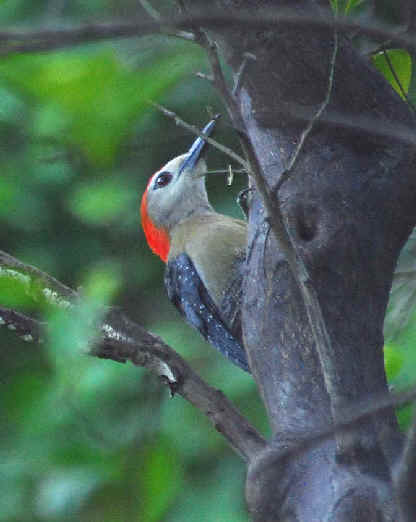
Jamaican Woodpecker
(photo by Suzanne Bradley)
- Puerto Rican Woodpecker (*) (ph) ______ PR:feb,mar,apr
(species endemic to Puerto Rico)
Melanerpes portoricensis (monotypic)
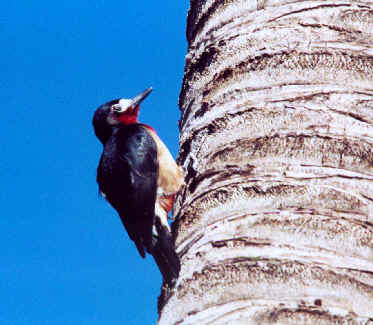
Puerto Rican Woodpecker, photographed during a FONT tour
- Guadeloupe Woodpecker (nt)
(*) ______ GD:feb (species
endemic to Guadeloupe)
Melanerpes herminieri (monotypic)
Regarding the GUADELOUPE WOODPECKER, go to: RARE BIRDS OF THE
CARIBBEAN
- Red-bellied Woodpecker (WIr) (ph)
______ BH(very
rare)
Melanerpes carolinus
A Red-bellied Woodpecker found on Grand Bahama Island on
February 15, 1999 was the first record for the West Indies.
The Red-bellied Woodpecker has been one of the few birds endemic to the
United States.
- Cuban Green Woodpecker ______ CU
(species endemic to Cuba)
Xiphidiopicus percussus
- Yellow-bellied Sapsucker (*) (ph)
______ BH CU
CY DR:dec
Sphyrapicus varius (monotypic)
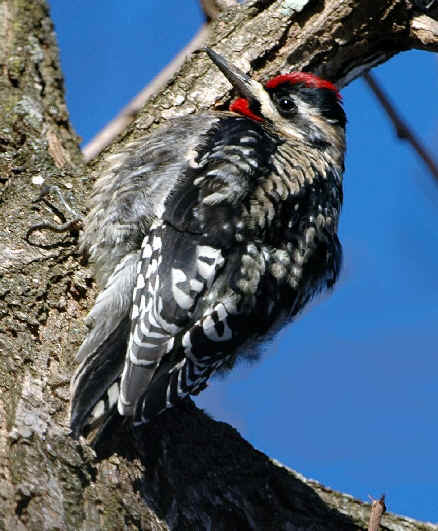
Yellow-bellied Sapsucker
(photo by Howard Eskin)
- "Yellow-shafted" Northern
Flicker (*) ______ CU CY:feb,jun,dec
Colaptes auratus gundlachi (subspecies
endemic to Grand Cayman Island)
- Fernandina's Flicker (t2) ______
BH(rare) CU (species
normally
endemic to
Cuba)
Colaptes fernandinae
- Hairy Woodpecker (ph) ______ BH
Picoides villosus
- Ivory-billed Woodpecker (t1) ______
(species now believed to be extinct)
Campephilus principalis
Recent DNA evidence (published in 2006) indicates that what has been said
to be a subspecies of the Ivory-billed Woodpecker in Cuba, Campephilus
principalis bairdi, is (was) not, First described in 1863 as a
separate species, the Cuban bird has been shown to a species more closely
related to the Imperial Woodpecker of Mexico than to the Ivory-billed
Woodpecker of the southeastern United States. By that year (2006), it may
well have been that all 3 of these woodpeckers had become extinct.
- Jamaican
Becard (*) ______ JM:mar,apr (species
endemic
to Jamaica)
Pachyramphus niger (monotypic)
The Jamaican Becard is the only becard of the
Caribbean.
Local names for the Jamacian Becard are "Mountain
Judy" for the female, and "Mountain Dick" for the
male.
FLYCATCHERS
- Gray Kingbird (*) (ph) ______ AT:feb
BD:jul BH BU:feb
CU
CY:feb,jun DM:jan,feb,mar
DR:jan,feb,mar,apr,jul,dec GD:feb GR HA JM:apr PR:feb,mar,apr
SL:mar,dec SV:mar,jul,dec
Tyrannus d. dominicensis (subspecies in
the Greater Antilles, also in parts of North, Central, & South
America)
Tyrannus dominicensis vorax (subspecies in the Lesser Antilles & Trinidad)
In Jamaica, a local name for the Gray Kingbird is "Petchary".
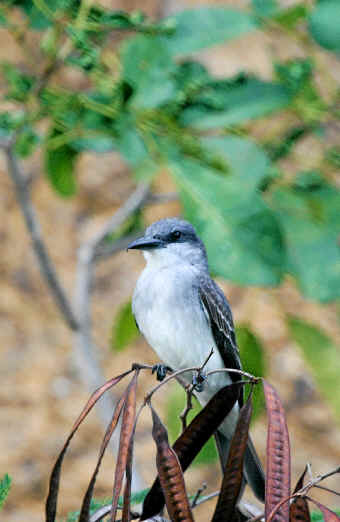
Gray Kingbird
(photographed by Marie Gardner in Saint Lucia
during the Dec 2007 FONT Lesser Antilles Tour)
-
Loggerhead Kingbird (*) (ph) ______ BH CU
CY:feb,jun,dec
DR:feb,mar,apr,dec JM:mar,apr PR:feb,mar,apr
Tyrannus caudifasciatus caymanensis (subspecies
endemic to the Cayman Islands)
Tyrannus
caudifasciatus flavescens (subspecies
endemic to Hispaniola & nearby small islands; another subspecies T.
c.
gabbii
occurs in Haiti)
Tyrannus caudifasciatus jamaicensis
(subspecies endemic to Jamaica)
Tyrannus caudifasciatus taylori (subspecies endemic to Puerto Rico)
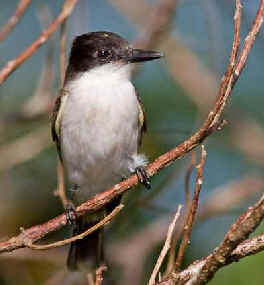
Loggerhead Kingbird
- Giant Kingbird (t2) ______ CU
(species now endemic to Cuba)
Tyrannus cubensis
The Giant Kingbird formerly occurred in the Bahamas.
- Eastern Kingbird (ph) ______
BH
CU
Tyrannus tyrannus
- Tropical Kingbird (ph) ______
CU(rare)
Tyrannus melancholicus
- Western Kingbird (ph) ______
BH(rare)
CU(rare)
Tyrannus verticalis
A Western Kingbird was on Grand Bahama Island in February 2001.
- Scissor-tailed Flycatcher (ph) ______
BH(rare)
CU(rare)
Tyrannus forficatus
A Scissor-tailed Flycatcher in Cuba in January 1999 was said
to be the fourth record of the species for that island.
- Fork-tailed Flycatcher (ph) ______
CU(rare) DR(very
rare) GD(very rare)
Tyrannus savana
A Fork-tailed Flycatcher was in Guadeloupe on September 9, 2008.
- Great Crested Flycatcher (*) (ph) ______
BH(rare) CU PR(rare)
Myiarchus crinitus (monotypic)
- LaSagra's Flycatcher (*) ______
BH CU
CY:feb,jun,dec
Myiarchus s. sagrae
(subspecies of the Caymans & Cuba)
- Stolid Flycatcher (*) ______ DR:jan,feb,mar,apr,jul,dec
JM:mar,apr
Myiarchus stolidus dominicensis
(subspecies endemic to Hispaniola)
Myiarchus s. stolidus (subspecies
endemic to Jamaica)
In Jamaica, a local name for the Stolid Flycatcher is "Tom
Fool".
- Rufous-tailed Flycatcher (*) ______ JM:mar,apr
(species endemic to Jamaica)
Myiarchus validus (monotypic)
A local name for the Rufous-tailed Flycatcher is "Big
Tom Fool".
- Sad Flycatcher (*) ______
JM:mar,apr (species
endemic
to Jamaica)
Myiarchus barbirostris (monotypic)
A local name for the Sad Flycatcher is "Little Tom
Fool".
- Puerto Rican Flycatcher (*) (ph) ______ PR:feb,mar,apr
(species endemic to Puerto Rico & the
Virgin Islands)
Myiarchus antillarum (monotypic)
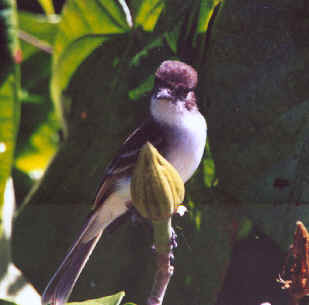
A Puerto Rican Flycatcher photographed during a
FONT tour
- Lesser Antillean Flycatcher (LAe) (*) ______
DM:jan,feb,mar GD:feb SL:mar,dec
Myiarchus o. oberi (subspecies restricted to Dominica & Guadeloupe)
Myiarchus oberi sanctaeluciae (subspecies endemic to St. Lucia)
- Grenada Flycatcher (LAe) (*) ______
GR SV:mar
Myiarchus nugator (monotypic)
- Willow Flycatcher ______ CU(rare)
JM(rare)
Empidonax trailli
A Willow Flycatcher was in Jamaica, at Windsor Caves on
November 10, 1999.
- Acadian Flycatcher ______ BH
CU
Empidonax virescens
- Yellow-bellied Flycatcher ______ CU(rare)
Empidonax flaviventris
- Least Flycatcher (WIr) ______
Empidonax minimus
- Euler's Flycatcher (WIr) ______
GR(very rare, or
extirpated)
Lathrotriccus euleri
- Eastern Wood Pewee (*) (ph) ______ BH
CU CY:dec
DR(rare)
Contopus virens (monotypic)
An Eastern Wood Pewee in the Dominican Republic in
October 2005 was said to be the first record of the species for that
country.
- Hispaniolan
Pewee (*) ______ DR:jan,feb,mar,apr,dec
(species endemic to Hispaniola)
Contopus h. hispaniolensis (another
subspecies on the offshore Gongave Island)
The Hispaniolan Pewee was part of what was the Greater
Antillean Pewee, now split into 3 species:
the Hispaniolan Pewee, the Crescent-eyed Pewee (below),
and the Jamaican Pewee (below).
- Crescent-eyed Pewee ______ BH
CU
Contopus caribaeus
- Jamaican Pewee (*) ______
JM:mar (species
endemic
to Jamaica)
Contopus pallidus (monotypic)
- Puerto Rican Pewee (*) (ph) ______
PR:feb,mar,apr (species endemic to Puerto Rico)
Contopus (latirostris) portoricensis (monotypic)
The Puerto Rican Pewee was considered part of the Lesser
Antillean Pewee (below).
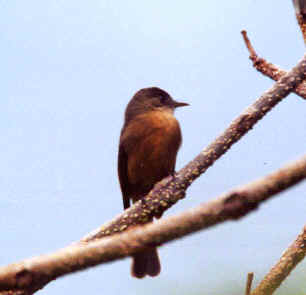
A Puerto Rican Pewee photographed during a FONT tour
- Saint Lucia Pewee (LAe) (*) ______
SL:mar,dec (species
endemic
to St. Lucia)
Contopus (latirostris) oberi (monotypic)
The Saint Lucia Pewee was considered part of the Lesser
Antillean Pewee (below).
- Lesser Antillean Pewee (LAe) (*)
______ DM:jan,mar (now
a species in Dominica, Guadeloupe, & Martinique)
Contopus latirostris
(formerly a subspecies C. l. brunneicapillus)
- Western Wood Pewee ______ CU(rare)
Contopus sordidulus
- Olive-sided Flycatcher (nt)
______ NA
Contopus cooperi
- Eastern Phoebe (ph) ______ BH(rare)
CU(rare)
Sayornis phoebe
Two records of Eastern Phoebes on Grand Bahama Island in November
1995 (2 different birds, 2 days apart) were the first published records for
the West Indies since one was in the Bahamas, on Eleuthera Island, in February
1986.
At that time (1995), these were the only records in the Bahamas since
one in 1972.
- Greater Antillean Elaenia (*)
______ DR:jan,feb,mar,apr,jul,dec JM
Elaenia fallax cherriei (subspecies
endemic to Hispaniola)
Elaenia f. fallax (subspecies
endemic to Jamaica)
- Caribbean Elaenia (*) ______
BD:jul BU:feb CY:feb,jun,dec DM:jan,mar GR PR:feb,mar,apr SL:mar,dec
SV:mar,jul,dec
Elaenia martinica caymanensis
(subspecies
endemic to the Cayman Islands)
Elaenia m. martinica (subspecies of Puerto Rico & the Lesser Antilles)
- Yellow-bellied Elaenia (*) (ph) ______ GR
SL(r) SV:mar,jul,dec
Elaenia f. flavogaster
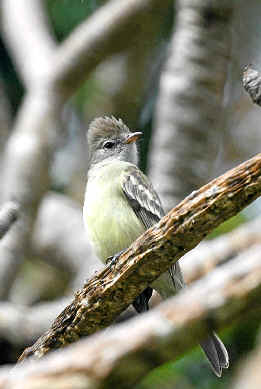
Yellow-bellied Elaenia
(photographed by Marie Gardner in Saint Vincent
during the Dec 2007 FONT Lesser Antilles Tour)
- Jamaican Elaenia (*) ______
JM:mar (species endemic to Jamaica)
Myiopagis cotta (monotypic)
A local name for the Jamaican Elaenia is "Sarah
Bird".
VIREOS
- Thick-billed Vireo (*) ______
BH CU CY:feb,jun
Vireo crassirostris alleni (subspecies endemic to the Cayman Islands)
- Flat-billed
Vireo (*) ______ DR:feb,mar,apr,jul,dec (species
endemic
to Hispaniola)
Vireo nanus (monotypic)
- Jamaican Vireo (*) ______ JM:mar,apr
(species endemic to Jamaica)
Vireo modestus (monotypic)
A local name for the Jamaican Vireo is "Sewi-sewi"
(similar to its song).
- Blue Mountain Vireo (nt) (*) ______
JM:mar,apr (species
endemic
to Jamaica)
Vireo osburni (monotypic)
- Puerto Rican Vireo (*) ______ PR:feb,mar,apr
(species endemic to Puerto Rico)
Vireo latimeri
(monotypic)
-
Red-eyed Vireo (*) ______ BH CU PR:feb(rare)
Vireo o. olivaceus
-
Black-whiskered Vireo (*) ______ BD:jul BH
CU
CY DM:jan,mar
DR:feb,mar,apr,jul GD:feb JM:mar,apr PR:feb,mar,apr SL:mar SV:mar
Vireo altiloquus barbadensis (subspecies occurring from St. Croix in the
Virgin Islands south to Barbados)
Vireo a. altiloquus (subspecies in the Greater Antilles and the Cayman
Islands; it migrates in its non-breeding season to northern South
America)
In Jamaica, a local name for the Black-whiskered Vireo is "John
To-Whit" (similar to its song).
- Yucatan Vireo (*) (ph) ______ CY:feb,jun,dec
Vireo magister caymanensis (subspecies
endemic on Grand Cayman Island, the only subspecies on an West
Indian island, although 2 subspecies occur on islands off Belize &
Honduras)
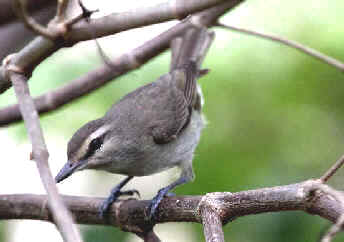
Yucatan Vireo
(photo by Marie Gardner)
- Cuban Vireo ______ CU
(species endemic to Cuba)
Vireo gundlachii
- Mangrove Vireo ______
Vireo pallens
- White-eyed Vireo (ph) ______
BH
CU
Vireo griseus
- Yellow-throated Vireo ______ BH
CU DM(very rare) JM(rare)
Vireo flavifrons
A Yellow-throated Vireo was in Jamaica at Marshall's Pen in
November 1999.
A Yellow-throated Vireo on Dominica, in a published report
in 2005, was said to be the first record for that island since 1904.
- Blue-headed Vireo (ph) ______ BH(rare)
CU(rare)
Vireo solitarius
- Warbling Vireo ______ CU(rare)
Vireo gilvus
During the winter of 2000/01, a Warbling Vireo in Cuba was
said to be the first winter record for the species in the West Indies.
- Philadelphia Vireo ______ BH
CU NA(rare)
Vireo philadelphicus
A Philadelphia Vireo in the Netherland Antilles on the
island of Curacao on April 1, 2000 was said to be the first record of
the species for that island.
CROWS
- White-necked Crow
(t3) (*) ______
DR:feb,mar,apr,jul,dec
(species now endemic to
Hispaniola) (formerly occurred in
Puerto Rico, last recorded there in the 1960s)
Corvus leucognaphalus (monotypic)
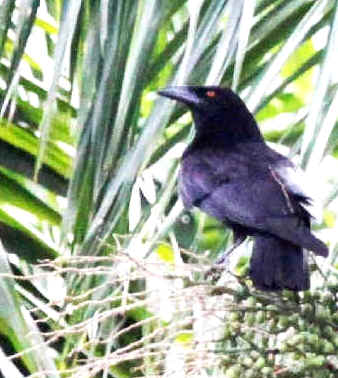
A White-necked Crow photographed during the
FONT tour in the Dominican Republic in April 2012.
This species is the rarest of the crows in the Americas. Now endemic to
Hispaniola, where it is rare & local,
it also occurred in Puerto Rico, where it became extinct in the 1960s.
Where the bird still occurs, its laugh-like calls and squawks can be heard,
In this photo, white on the neck can not be seen, but a red eye can
be.
(photo by Marie Gardner)
- Hispaniolan Palm Crow (nt) (*) ______ DR:feb,mar,apr,jul,dec (species
endemic
to Hispaniola)
Corvus palmarum
The Hispaniolan Palm Crow has been considered conspecific with the
Cuban Palm Crow (below).
- Cuban Palm Crow (t2) ______
CU (species
endemic to
Cuba)
Corvus minutus
- Cuban Crow ______ BH
CU
Corvus nasicus
- Jamaican Crow (*) ______
JM:mar,apr (species endemic to Jamaica)
Corvus jamaicensis
(monotypic)
A local name for the Jamaican Crow is the "Jabbering
Crow".
- Fish Crow ______
BH(very
rare)
Corvus ossifragus
A Fish Crow on Grand Bahama Island in February 1997 was the
first West Indian record.
The Fish Crow has been one of the few birds endemic to the United
States.
WAXWING
- Cedar Waxwing (ph) ______ BH(rare)
CU PR(very rare)
Bombycilla cedrorum
There have been sight records of Cedar Waxwings in Puerto Rico
in 1981, 1982, and more recently in 2007.
PALMCHAT
- Palmchat (*) (ph) ______ DR:jan,feb,mar,apr,jul,dec
(species & family endemic to Hispaniola)
Dulus dominicus (monotypic,
and the single member of its genus & family, endemic to Hispaniola)
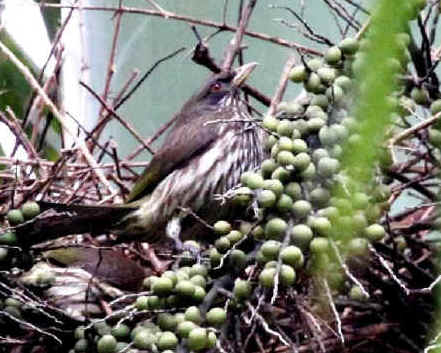
Above: a Palmchat during the FONT Dominican Republic
Tour in February 2012
Below: a large Palmchat nest photographed during an earlier FONT tour
(upper photo by Marie Gardner; lower photo by Jennie
Gaitskill)
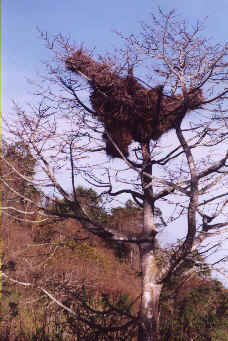
MARTINS
and
SWALLOWS
- Caribbean Martin (*) ______ BD:jul
BH(rare)
DM:mar
DR:feb,mar,apr,jul,dec GD:feb JM:apr PR:feb,mar SL:mar SV:mar,jul
Progne dominicensis
(now monotypic)
The Caribbean Martin has been considered conspecific with
the Sinaloa (or Snowy-bellied) Martin of Mexico.
What were said to be first and early records for the Caribbean Martin in
Trinidad were in: April-May 1999, April-May 2000, and February-April
2001.
- Purple Martin (*) (ph) ______
BH
CU CY JM(rare)
Progne s. subis
Some sightings during FONT tours of males in Jamaica and the Cayman
Islands are probably Purple Martin,
but possibly Cuban Martin (below)..
- Cuban Martin ______ BH(rare)
CU
Progne cryptoleuca
- Golden
Swallow (t3) (*) ______ DR:feb,mar,apr,jul,dec
(species may now be endemic to Hispaniola)
Tachycineta euchrysea sclateri (subspecies
endemic to Hispaniola; the only other subspecies, on Jamaica, may now be
extinct)
Regarding the GOLDEN SWALLOW, go to: RARE BIRDS OF THE CARIBBEAN
- Tree Swallow (*) (ph) ______ BH
CU DR
JM PR
Tachycineta bicolor
(monotypic)
About 100 Tree Swallows in Santo Domingo, in the Dominican
Republic on March 20, 1999 was, at the time, the largest number ever
known to have occurred in the country.
- Bahama Swallow (t2) ______ BH
CU(rare)
Tachycineta cyaneoviridis
- White-winged Swallow (WIr)
______ GR(very rare)
Tachycineta albiventer
A White-winged Swallow on Grenada by St. George's Harbor in
December 2005 was said to be a first record for that island.
- Bank
Swallow (*) ______ BH CU PR:feb
(called Sand Martin in the Old
World)
Riparia r. riparia
-
Northern Rough-winged Swallow (*) (ph) ______ BD(rare) BH
CU DR(rare) JM(rare)
PR(rare) SL(rare)
Stelgidopteryx s. serripennis
A Northern Rough-winged Swallow on Barbados in the fall of
1997 was said to be first record of the species for that island.
A Northern Rough-winged Swallow in Saint Lucia on March
17, 1990 was said to be the first record of the species for that island.
A Northern Rough-winged Swallow in the Dominican Republic, at
Cabo Rojo, on March 22, 1999 was said to be the 7th record of the species for the
country.
A Northern Rough-winged Swallow was seen at Rocklands, near Montego
Bay, Jamaica, on November 11, 1999.
-
Barn Swallow (*) (ph) ______ BH CU CY:feb,jun,dec DM:mar DR:jan,feb.mar,apr
JM:apr PR:feb,apr SL SV
Hirundo rustica erythrogaster
- "Antillean" Cave Swallow (*) (ph) ______
CU DR:feb,arm,apr,jul
JM:mar,apr PR:feb,mar,apr
Petrochelidon fulva (formerly Hirundo fulva)
Petrochelidon fulva cavicola (subspecies endemic to Cuba)
Petrochelidon f. fulva (subspecies endemic
to Hispaniola)
Petrochelidon
fulva poeciloma
(subspecies
endemic to Jamaica)
Petrochelidon
fulva puertoricensis
(subspecies endemic to Puerto Rico)
(4 subspecies in the Caribbean; 2 other subspecies in Mexico & in the
southwest
US)
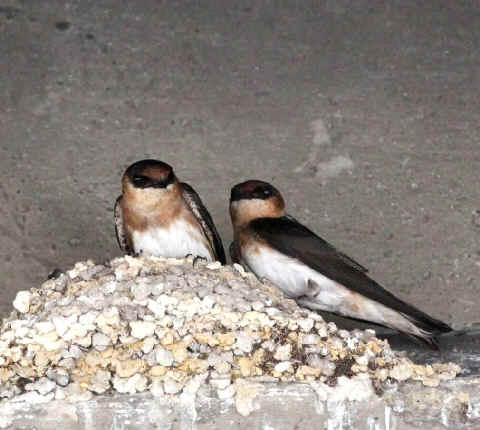
Antillean Cave Swallows at a nesting site in the
Dominican Republic
during a FONT tour in April 2012
(photo by Marie Gardner)
- American Cliff Swallow ______ BH
CU
Petrochelidon pyrrhonota (formerly Hirundo
pyrrhonota)
KINGLETS
- Ruby-crowned Kinglet (ph) ______
BH(rare)
CU(rare)
Regulus calendula
A Ruby-crowned Kinglet in the Zapata region of Cuba on
November 17, 2000 was said to be second record of the species for that
island.
WRENS
- House Wren ______ BH(rare)
CU(rare)
Troglodytes aedon
- "Saint Lucia Wren" (*)
______ SL (part of the House
Wren)
Troglodytes aedon mesoleucus (t3)
(subspecies endemic to St. Lucia)
- "Saint Vincent Wren" (*) ______
SV:mar (part of the House Wren)
Troglodytes aedon musicus (t3) (subspecies
endemic to St. Vincent)
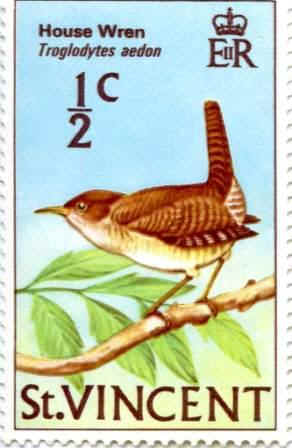
A stamp with the "Saint Vincent
Wren"
- "Lesser Antillean" House Wren
(*) ______ DM:jan,feb,mar GR (part of the House
Wren)
Troglodytes aedon rufescens
(subspecies endemic to Dominica)
Troglodytes aedon grenadensis (subspecies endemic to Grenada)
- Zapata Wren (t2) ______ CU
(species endemic to Cuba)
Ferminia cerverai
- Cuban Gnatcatcher ______ CU
(species endemic to Cuba)
Polioptila lembeyi
- Blue-gray Gnatcatcher (ph) ______
BH CU
Polioptila caerulea
- Brown-headed Nuthatch (ph) ______
BH(rare)
Sitta pusilla
THRASHERS
- Gray Catbird (*) (ph) ______ BH
CU
CY:feb
Dumetella carolinensis (monotypic, and the single member of its genus)
- Northern Mockingbird (*) (ph) ______
BH
CU CY:feb,jun,dec
DR:jan,feb,mar,apr,jul,dec JM:mar,apr PR:feb,mar,apr
Mimus polyglottos orpheus (resident
subspecies of the Caribbean, mostly in the Greater Antilles)

Northern Mockingbird
(photo by Howard Eskin)
- Bahama Mockingbird (*) ______
BH CU JM:mar
Mimus gundlachii hillii (subspecies endemic to Jamaica) (the
other subspecies in the Bahamas & on small islands off Cuba)
- Tropical Mockingbird (*) (ph) ______ DM:jan,mar
GD:feb GR SL:mar,dec SV:mar
Mimus gilvus antillarum (subspecies endemic to the Lesser Antilles)
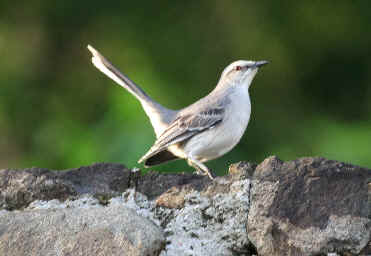
A Tropical Mockingbird in Saint Lucia
(photo by Marie Gardner during the Dec 2007 FONT Lesser Antilles Tour)
- Scaly-breasted Thrasher (LAe) (*)
______ DM:feb,mar GD:feb SL:mar,dec
SV:mar,jul,dec
Allenia fuscus (has been Margarops fuscus)
(now the single member of
its genus)
Allenia fuscus hypenema (subspecies in Dominica & other northern
Lesser Antillean islands)
Allenia fuscus schwartzi (subspecies endemic to St.
Lucia)
Allenia fuscus vincenti (subspecies endemic to St. Vincent)
The Scaly-breasted Thrasher is now possibly extirpated on St.
Eustatius, Barbuda, and Barbados.
- Pearly-eyed Thrasher (*) (ph) ______
BH BU:feb
DM:mar GD:feb PR:feb,mar,apr SL:mar,dec
Margarops fuscatus
(now the single member of its genus)
Margarops f. fuscatus (subspecies in Puerto Rico, Hispaniola, &
in the northern Lesser
Antilles, including Dominica)
Margarops fuscatus klinikowskii
(subspecies endemic to St. Lucia)
On Hispaniola, the Pearly-eyed Thrasher occurs only on Beata
Island and at the northeast corner of the Dominican Republic.
In the southern Caribbean, the Pearly-eyed Thrasher occurs on the
island of Bonaire.
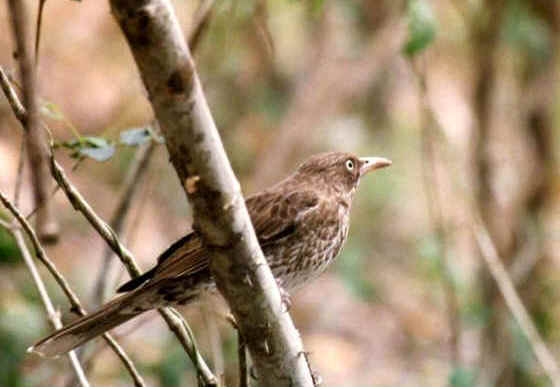
A Pearly-eyed Thrasher in Puerto Rico
(photo by Marie Gardner during a FONT Tour)
- White-breasted Thrasher
(t2)
(LAe) (*) ______ SL:mar (this rare species restricted to St. Lucia
and Martinique)
(the single member of its genus)
Ramphocinclus brachyurus brachyurus (subspecies
endemic to Martinique)
Ramphocinclus brachyurus sanctaeluciae (subspecies
endemic to St.
Lucia)
- Gray Trembler (LAe) (*) ______
SL:mar,dec (this species restricted to the 2 islands of St. Lucia
and Martinique)
Cinclocerthia gutturalis macrorhyncha
(subspecies endemic to St.
Lucia)
- Brown Trembler (LAe) (*) (ph) ______
DM:jan,feb,mar
SV:mar,jul,dec
Cinclocerthia r. ruficauda (subspecies endemic to Dominica)
Cinclocerthia ruficauda tenebrosa (subspecies
endemic to St. Vincent)
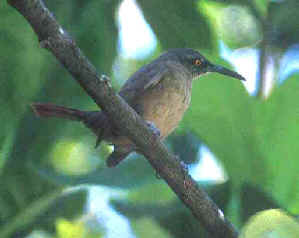
A Brown Trembler photographed during a FONT tour
- Brown Thrasher ______ BH(rare)
CU(rare)
Toxostoma rufum
STARLING and MYNA
- Common Starling (i) (*) (ph) ______
BH CU JM:mar,apr
Sturnis vulgaris
- Hill Myna (i) (*) ______ PR:apr
(species native to
southeast Asia)
Gracula religiosa
THRUSHES
- Spectacled Thrush (*) ______
DM GD SL:mar SV:mar,jul,dec
Turdus n. nudigenis
The Spectacled Thrush has also been called the American
Bare-eyed Thrush, or simply the Bare-eyed Thrush.
The first record of the Spectacled Thrush on Guadeloupe was
of an adult feeding young at Petit Marquisat at Capeesterre Belle-Eau in July
1997.
- Lesser Antillean Thrush (*) ______ SV:mar,jul,dec
Turdus personus bondi (subspecies endemic to St. Vincent; the other
subspecies on Grenada)
The Lesser Antillean Thrush was part of the Cocoa Thrush
of South America.
- Red-legged Thrush (*) (ph) ______
BH
CU DM:jan,mar
DR:feb,mar,apr,jul,dec PR:feb,mar,apr
Turdus plumbeous albiventris (subspecies endemic
to Dominica)
Turdus plumbeus ardosiaceus (subspecies in Hispaniola & Puerto Rico)
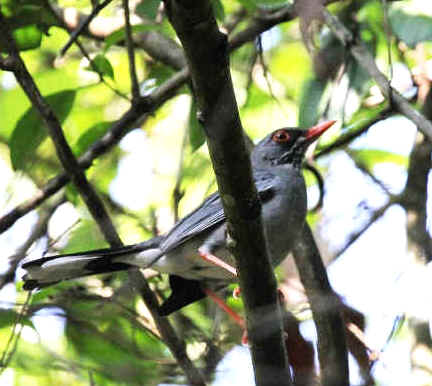
A Red-legged Thrush during the FONT tour in the
Dominican Republic in April 2012
(photo by Marie Gardner)
- LaSelle Thrush (t2) (*) ______ DR:feb,mar,apr
(species endemic to Hispaniola)
Turdus s. swalesi (1 of 2
subspecies, both on Hispaniola)
Turdus swalesi dodae (2nd Hispaniolan subspecies, described
in 1986)
- White-eyed Thrush (*) ______ JM:mar,apr
(species endemic to Jamaica)
Turdus jamaicensis (monotypic)
A local name for the White-eyed Thrush is the "Shine-eye".
- White-chinned Thrush (*) ______ JM:mar,apr
(species endemic to Jamaica)
Turdus aurantius
(monotypic)
A local name for the White-chinned Thrush is the "Hopping
Dick".
- Forest Thrush (nt) (LAe) (*) ______ DM:jan,feb,mar
GD:feb
Turdus iherminiieri (formerly Cichlherminia lherminieri)
Turdus lherminieri dominicensis
(subspecies endemic to Dominica)
Turdus lherminieri iherminia (subspecies endemic to
Guadeloupe)
Turdus lherminieri lawrenci (subspecies endemic to
Montserrat)
Turdus lherminieri sanctaeluciae (subspecies endemic to St.
Lucia, where now possibly extirpated)
Regarding the FOREST THRUSH, go to: RARE BIRDS OF THE
CARIBBEAN
- American Robin (ph) ______ BH
CU
Turdus migratorius
- Bicknell's Thrush (t3) ______
CU DR:feb
Catharus bicknelli
- Gray-cheeked Thrush ______ BD(rare)
CU
Catharus minimus
A Gray-cheeked Thrush on Barbados in the fall of 1997 was
said to be the first record of the species for that island.
- Swainson's Thrush ______ BD(rare)
BH(rare)
CU DR(rare) PR(rare)
Catharus ustulatus
A Swainson's Thrush on Barbados in the fall of 1997 was said
to be the first record of the species for that island.
A Swainson's Thrush in the Dominican Republic in October
2005 was said to be the first record of the species for the country.
Also in October 2005, a Swainson's Thrush in Puerto Rico was
said to be the first record of the species for that
island.
- Veery ______
BH CU PR(rare)
Catharus fuscescens
A Veery in Puerto Rico in October 2005 was said to be the
first record of the species for that island.
- Hermit Thrush (ph) ______ BH(rare)
CU(rare)
Catharus guttatus
An immature Hermit Thrush trapped on December 25, 1995 in Cuba
was said to be the first record of the species for that island.
- Wood Thrush ______ BH(rare)
CU
Hylacichla mustelina
- Rufous-throated Solitaire (*) ______
DM:jan,feb,mar DR:feb,mar,apr,jul,dec JM:mar,apr SL:mar,dec
Myadestes genibarbis dominicanus (subspecies endemic to Dominica)
Myadestes genibarbis genibarbis (subspecies endemic to
Martinique)
Myadestes genibarbis montanus
(subspecies endemic to Hispaniola)
Myadestes genibarbis solitarius
(subspecies endemic to Jamaica)
Myadestes genibarbis sanctaelucinae (subspecies endemic to St. Lucia)
There are now 5 subspecies in the Caribbean, with the Saint Vincent Solitaire
(below) having recently been split.
In Jamaica, a local name for the Rufous-throated Solitaire is the "Mountain
Whistler".
- Saint Vincent Solitaire (*) ______ SV:dec
(endemic to St, Vincent) (was part of the Rufous-throated Solitaire)
Myadestes sibilans (monotypic)
- Cuban Solitaire (nt) ______
CU (species endemic to Cuba)
Myadestes elisabeth
- Eastern Bluebird (ph) ______
BH(rare)
CU(rare)
Sialia sialis
- Northern Wheatear (ph) ______
BH(rare)
CU(rare)
Oenanthe oenanthe
various
OLD WORLD SPECIES (introduced)
- House Sparrow (i) (*) ______ BH
CU
DR:feb,mar,apr,jul,dec
HA:apr JM:mar PR:feb,mar,apr SL(rare)
SV;dec
(species native to
Eurasia)
Passer domesticus
Rare on Saint Lucia, a House Sparrow was seen there in
March 1999.
- Village Weaver (i) (*) (ph) ______ DR:feb,mar,apr,jul,dec
(species native to Africa; First found in Haiti in 1796, now widespread
throughout Hispaniola.)
Ploceus cucullatus
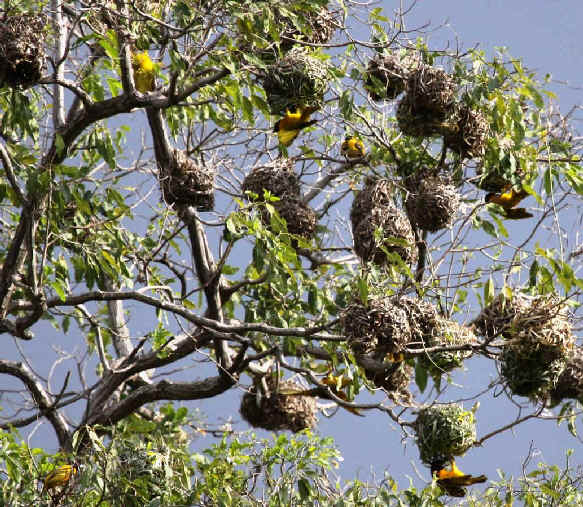
Above: a nesting
colony of Village Weavers during the FONT tour
in the Dominican Republic in April 2012.
Below: a male and a female Village Weavers about to get a drink
during the FONT Dominican Republic Tour in February 2012
(photos by Marie Gardner)
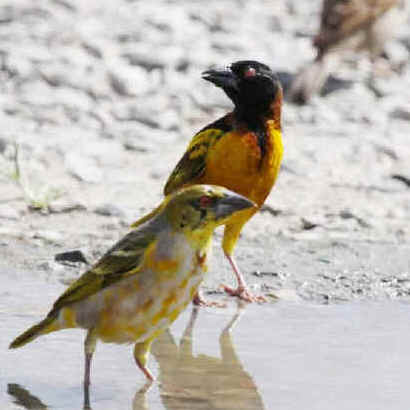
- Yellow-crowned Bishop (has
also been called Napolean Weaver) (i)
(*) ______
PR:mar (species
native to Africa)
Euplectes afer
- Red (or Orange) Bishop
(i) (*) ______
PR
(species native to Africa, where now 2 species: Northern Red Bishop &
Southern Red Bishop)
Euplectes franciscanus
-
Orange-cheeked Waxbill (i) (*) ______ PR:apr
(species native to central west Africa)
Estrilda melpoda
-
Indian Silverbill
(has also been called Warbling Silverbill or White-throated Munia) (i) ______
PR:feb
(species native from Africa thru India)
Lonchura malabarica
- Bronze Mannikin (has
also been called
Hooded Weaver) (i) (*) ______ PR:feb,mar,apr
(species native to
Africa)
Lonchura cucullata
-
Scaly-breasted Munia (has
also been called Nutmeg Mannikin or Spice Finch) (i)
(*) ______ CU
DR:apr,dec PR (species
native to India & southeast Asia)
Lonchura punctulata
- Black-headed Munia (has
also been called Chestnut Mannikin or Tricolored Munia) (i) (*) ______
CU JM:mar
PR:feb,mar
(species native to India & southeast Asia)
Lonchura malacca
-
Java Sparrow (i) (*) ______ PR
(species native to
Indonesia)
Padda oryzivora
-
Pin-tailed Whydah (i) (*) ______ PR:apr
(species native to
Africa)
Vidua macroura
PIPITS
- American Pipit ______
BH(rare)
Anthus spinoletta
EUPHONIAS
- Antillean Euphonia (*) ______ DM
DR:feb,mar,apr,dec PR:feb,mar SL SV:mar
Euphonia m. musica (subspecies
endemic to Hispaniola)
Euphonia
musica sclateri (subspecies endemic to Puerto Rico)
Euphonia musica flavifrons (in this subspecies, in the Lesser Antilles,
the plumages of the two sexes are alike, similar to the females of the other 2
subspecies in the Greater Antilles)
The Antillean Euphonia was called the Blue-hooded Euphonia,
when it was conspecific with what is now the Elegant Euphonia in
Central America and the Golden-rumped Euphonia in South America.
- Jamaican Euphonia (*) ______ JM:mar,apr
(species endemic to Jamaica)
Euphonia jamaica (monotypic)
A local name for the Jamaican Euphonia is the "Blue
Quit".
SISKINS & CROSSBILL
- Antillean
Siskin (*) (ph) ______ DR:feb,mar,apr,jul (species
endemic
to Hispaniola)
Carduelis (or Spinus) dominicensis
(monotypic)
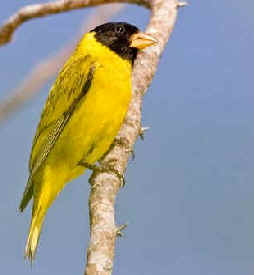
A male Antillean Siskin
- American Goldfinch (ph) ______
BH(rare) CU(rare)
Carduelisus
(or Spinus) tristis
- Red Siskin (t2) (i)
______ PR
Sporagra (formerly Carduelis) cucullata
- Hispaniolan Crossbill (t2) (*) (ph) ______
DR:feb,mar,apr (species
endemic
to Hispaniola)
Loxia megaplaga
The Hispaniolan Crossbill was considered part of the White-winged
Crossbill, Loxia leucoptera, a species called the Two-barred
Crossbill in Europe.
Regarding the HISPANIOLAN CROSSBILL, go to: RARE BIRDS OF THE
CARIBBEAN
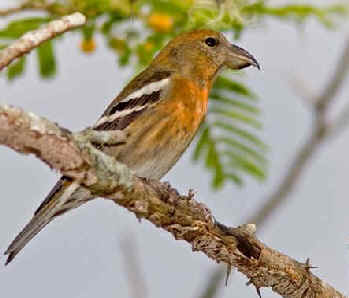
Hispaniolan Crossbill
NEW WORLD WARBLERS
- Black-and-white Warbler (*) ______
BH
CU CY:feb
DM
DR:feb,mar,apr,dec JM:mar,apr PR:mar
Mniotilta varia (monotypic, and the single member of its genus)
-
Prothonotary Warbler (*) (ph) ______ BH
CU
DM:mar DR:mar
PR,SL
Protonotaria citrea (monotypic, and the single member of its
genus)
-
Worm-eating Warbler (*) ______ BH
CU
DR:dec
JM:mar,apr PR
Helmitheros vermivorus (monotypic, and the single member of its genus)
- Swainson's Warbler (*) ______
BH CU DR(rare)
JM PR(rare)
Limnothlypis swainsonii (monotypic,
and the single member of its genus)
A Swainson's Warbler was netted in the Dominican Republic in
the Sierra de Baoruco in November 1997 & March 1998 (the same bird). A
second bird was also netted in March 1998. The first of these was said to be
the first record for Hispaniola.
Later, single Swainson's Warblers were netted in the Sierra de
Baoruco in January 2000 and January 2001. These were said to be the 3rd
& 4th records of the species for Hispaniola.
A Swainson's Warbler was in the Maricao Forest in Puerto Rico
in January 1992.
- Blue-winged
Warbler (*) (ph) ______ BH CU
DR:mar
Vermivora pinus (monotypic)
- Golden-winged Warbler (nt) ______ BD(rare)
BH(rare)
CU(rare) DR(rare)
NA(rare)
Vermivora chrysoptera
(monotypic)
A Golden-winged Warbler on Barbados in the fall
of 1997 was said to be first record of the species for that
island.
Two Golden-winged Warblers were seen in the southwest Dominican
Republic, at Cabo Rojo near Pedernales, on October 14, 1997.
- Bachman's Warbler ______ (species
is now probably
extinct: it did occur in The Bahamas & Cuba)
Vermivora bachmanii
- Tennessee Warbler (*) (ph) ______
BH CU DR:apr
JM:mar
Oreothlypis (formerly Vermivora) peregrina (monotypic)
- Nashville Warbler (*) (ph) ______
BH
CU(rare) DR(rare)
JM:mar(rare)
Oreothlypis
(formerly Vermivora) r. ruficapilla
An adult female Nashville Warbler that was netted in the southwest Dominican
Republic, at Cabo Rojo near Pedernales, in November 1997 was said to be
the first record for the species in that country.
A Nashville Warbler was on Grand Bahama Island in February
2001.
Seen during a FONT tour, a Nashville Warbler in Jamaica from February 3,
2000 and continuing for at least a month was said to be the 4th record of
the species for that island.
- Orange-crowned Warbler (ph) ______
BH CU(rare)
Oreothlypis (formerly Vermivora) celata
An Orange-crowned Warbler was on Grand Bahama Island in February
2001.
- Northern Parula (*) (ph) ______
BH CU
CY:feb,dec
DR:feb,mar,apr,dec JM:mar,apr PR:feb,mar,apr
Setophaga (formerly
Parula) americana (monotypic)
-
Yellow Warbler (*) (ph) ______
BD:jul BH
BU:feb CU CY;feb,jun DM:jan,mar DR:feb,mar,apr JM:mar
PR:feb,mar,apr
SL:mar,dec
(some birds are resident in the Caribbean, while others are
migratory birds from North America that spend the winter in the Greater Antilles
and the Caymans)
Setophaga (formerly Dendroica) petechia
Setophaga petechia albicollis (subspecies endemic to Hispaniola)
Setophaga petechia alsiosa (subspecies endemic to the Grenadine
Islands)
Setophaga petechia armouri (subspecies endemic to Isla Providencia,
in the western Caribbean)
Setophaga petechia babad (subspecies endemic to St. Lucia)
Setophaga petechia bartholemica (subspecies in Puerto Rico, the Virgin
Islands, & the northern Lesser Antilles)
Setophaga petechia chlora (subspecies endemic to Siete Hermanos
Is., off Hispaniola)
Setophaga petechia eoa (subspecies in Jamaica & the Cayman
Islands)
Setophaga petechia flaviceps (subspecies endemic to the Bahamas)
Setophaga petechia flavida (subspecies endemic to Isla Andres, in
the western Caribbean)
Setophaga petechia gundlachi (subspecies in Cuba & south Florida,
US)
Setophaga petechia melanoptera (subspecies in the central Lesser
Antilles, including Dominica)
Setophaga p. petechia (subspecies, the nominate, endemic to
Barbados)
Setophaga petechia solaris (subspecies endemic to Gonave Is.,
off Hispaniola)
Setophaga petechia ruficapilla (subspecies endemic to Martinique)
Setophaga petechia rufopileata (subspecies on Aruba, Bonaire, and Curacao)
Setophaga petechia is now
considered distinct from the Mangrove Warbler of Central America, Setophaga
erithachorides.
The head of the adult male Yellow Warbler, Setophaga
petechia, varies from yellow (in the Bahamas & Cuba) to
entirely reddish-brown (on Martinique).
In between, there are varying amounts from a tinge (in Jamaica, Hispaniola,
Puerto Rico, and the Cayman Islands) to a distinct cap (in most of the Lesser
Antilles).
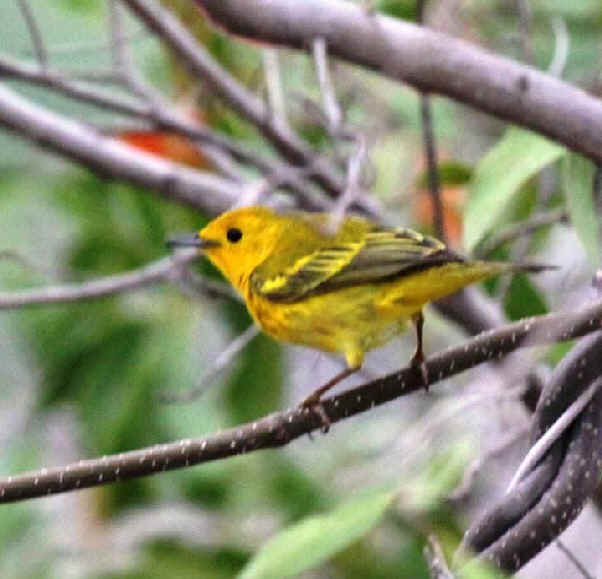
A Yellow Warbler photographed during the FONT tour
in the Dominican Republic in April 2012
(photo by Marie Gardner)
-
Magnolia Warbler (*) (ph) ______ BH
CU
DR:mar JM:feb,mar
PR
Setophaga (formerly
Dendroica) magnolia
(monotypic)
- Black-throated Blue Warbler (*) ______
BH CU CY:feb,dec
DR:feb,mar,apr,dec JM:mar,apr PR:apr
Setophaga (formerly Dendroica)
caerulescens (2 subspecies winter in the Greater Antilles of the Caribbean:
S. c.
caerulescens & S. c. cairnsi)
- Black-throated Green Warbler (*)
(ph) ______ BH CU DR:jan,mar
Setophaga (formerly Dendroica) virens
(now said to
be monotypic)
- Black-throated Gray Warbler (WIr)
______ CU(rare)
Setophaga (formerly Dendroica)
nigrescens
A Black-throated Gray Warbler photographed in Cuba on
October 17, 1997 was said to be the first record of the species for both
Cuba and the West Indies.
- Cape May Warbler (*) ______ BH
CU DM
DR:jan,feb,mar,apr,dec JM:mar PR:feb,mar
Setophaga (formerly
Dendroica) tigrina (monotypic)
-
Yellow-throated Warbler (*) (ph) ______ BH
CU
CY:feb
DR:feb,apr,dec JM,PR
Setophaga (formerly
Dendroica) dominica
(3 subspecies occur in the
Caribbean)
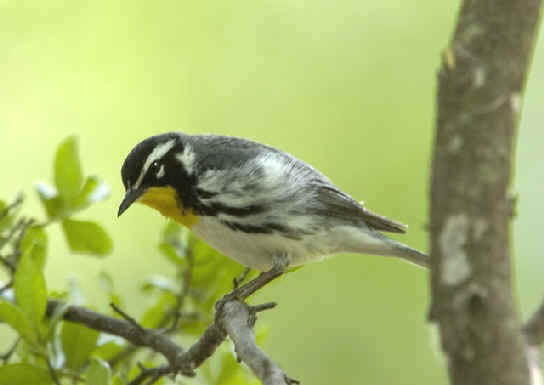
Yellow-throated Warbler
- Bahama Warbler (nt) ______
BH (was part of the Yellow-throated Warbler)
Setophaga flavescens
Formerly classified as a subspecies of the Yellow-throated Warbler, the
Bahama Warbler was raised to a full species status in 2011.
The Bahama Warbler is a habitat specialist, restricted to Caribbean
pine forests in the Bahamas on Abaco and Grand Bahama Island where it is a
resident.
In all plumages, the Bahama Warbler has more extensive yellow below
than does the Yellow-throated Warbler. Although Yellow-throated
Warblers are moderately long-billed, Bahama Warblers are very
long-billed.
The Bahama Warbler differs from the superficially-similar Kirtland's
Warbler in two significant behavorial aspects:
The Kirtland's Warbler is a habitual tail-pumper. The Bahama Warbler
is not.
The Bahama Warbler is a habitual "tree-creeper". The
Kirtland's is not.
Described here is the "tree-creeper" behavior of the Bahama
Warbler: "An individual warbler landed on the lower section of
a pine trunk and then worked its way upward, circling the tree and probing
beneath the bark much as a Brown Creeper does. After reaching the
branched portion of the tree, the warbler would fly to the base of another
tree and repeat its behavior."
Some Yellow-throated Warblers that breed in the southeastern US
coastal plain can be found in winter in the Bahamas. Such birds are yellow-lored,
as are Bahama Warblers, but they are distinguished from Bahama
Warblers by their relatively shorter bills, and by the relatively reduced
yellow of their underparts.
Yellow-throated Warblers on their Bahamian wintering grounds are more
generalized as to their ecology and distribution than are Bahama Warblers.
Yellow-throated Warblers may be found in a variety of habitats, in the
Bahamas as they are elsewhere, but Bahama Warblers are
restricted to pine woods.
Also, Yellow-throated Warblers may be found throughout the Bahamas, but
the Bahama Warbler occurs only on the northern islands of Grand Bahama
and Abaco, where it is uncommon to locally fairly
common.
- Chestnut-sided Warbler
(*) (ph)
______ BH CU DR(rare):apr JM
Setophaga (formerly Dendroica) pensylvanica
(monotypic)
An immature Chestnut-sided Warbler that was netted in the southwest
Dominican Republic, at Cabo Rojo near Pedernales, in October 1997 was said to
be the first record for the species in that country.
An adult male Chestnut-sided Warbler was observed during a FONT tour in
April 2006, in hills near Barahona in the southwest Dominican Republic.
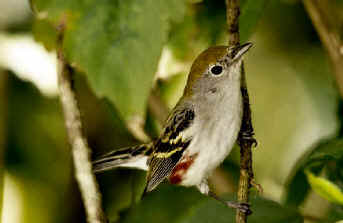
Chestnut-sided Warbler
(photo by Marie Grenouillet)
- "Myrtle" Yellow-rumped Warbler (*)
(ph) ______ BH CU CY:dec DR:feb,mar JM:apr PR:feb
Setophaga (formerly Dendroica) c. coronata
- Adelaide's Warbler (*) ______ PR:feb,mar,apr
(species endemic to Puerto Rico) (formerly included populations on other Caribbean islands of Barbuda and Saint
Lucia, each now considered separate species)
Setophaga
(formerly Dendroica) adelaidae
- Saint Lucia Warbler (LAe) (*) (ph) ______
SL:mar,dec (species
endemic to St. Lucia) (formerly conspecific with the Adelaide's Warbler
of Puerto Rico & the
Barbuda Warbler
of the small island of Barbuda)
Setophaga (formerly Dendroica) delicata
(monotypic)
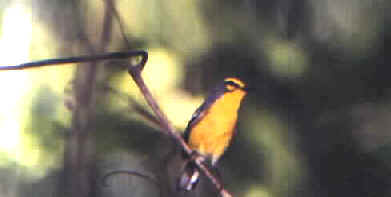
A Saint Lucia Warbler photographed during a FONT tour
- Barbuda Warbler (nt) (*)
______ BU:feb (species
endemic
to Barbuda)
Setophaga
(formerly Dendroica) subita
Regarding the BARBUDA WARBLER, go to: RARE BIRDS OF THE
CARIBBEAN
- Pine Warbler (*) (ph) ______ BH
CU(rare)
DR:feb,mar,apr,jul,dec
Setophaga
(formerly Dendroica) pinus chrysoleuca
(resident
subspecies endemic in Hispaniola)
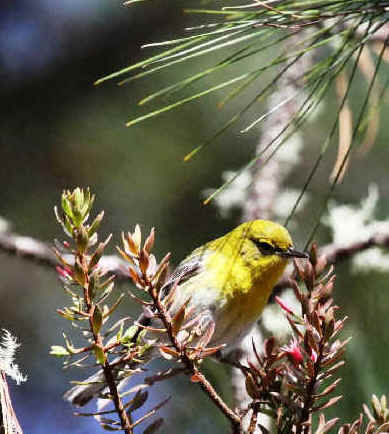
A Pine Warbler photographed in the Dominican
Republic
during a FONT tour in February 2012
(photo by Marie Gardner)
- Prairie Warbler (*) (ph) ______ BH
CU CY:feb
DR:jan,feb,mar,apr,dec GD
JM:mar PR:feb,mar SL
Setophaga (formerly
Dendroica) discolor (2 subspecies from
North America winter in the Caribbean: S.
d. discolor &
S. d. paludicola)
2 different Prairie Warblers were reported in Guadeloupe
on September 27, 2008.
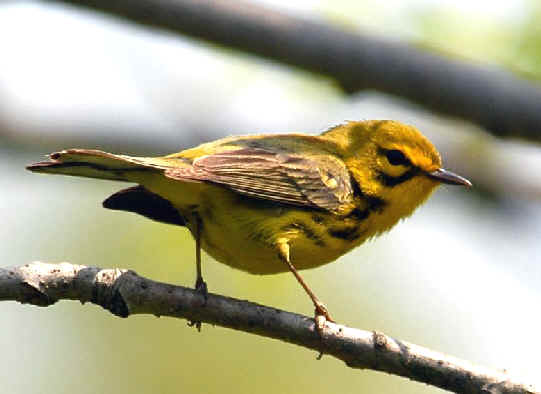
Prairie Warbler
(photo by Howard Eskin)
- Vitelline Warbler (nt) (*) ______ CY:feb,jun,dec
(a
quasi-endemic species of the Cayman Islands)
Setophaga
(formerly Dendroica) v. vitellina
(an
endemic subspecies on Grand Cayman Island)
Setophaga vitellina crawfordi (an
endemic subspecies on Little Cayman Island)
- Palm Warbler (*) ______
BH
CU CY:feb,dec
DR:feb,mar,apr,dec GD JM:mar,apr PR
Setophaga
(formerly Dendroica) p. palmarum
A Palm Warbler in Guadeloupe on September 25, 2008 was a first
fall record for that island.
- Cerulean Warbler (t3) ______ BH(rare)
CU(rare) NA
Setophaga (formerly Dendroica) cerulea
- Blackburnian Warbler ______ BH
CU
Setophaga
(formerly Dendroica) fusca
- Blackpoll Warbler (ph) ______ BH
CU
Setophaga
(formerly Dendroica) striata
- Bay-breasted Warbler ______ BH
CU DR(rare)
Setophaga
(formerly Dendroica) castanea
A juvenile male Bay-breasted Warbler that was netted in the southwest
Dominican Republic, at Cabo Rojo near Pedernales, in October 1997 was said
to be the first record for the species in that country.
In an article in 2009 in "Caribbean Ornithology", it was said that
there has been a first record of the Bay-breasted Warbler for Aruba
in the Netherlands Antilles.
- Townsend's Warbler ______ BH(rare)
Setophaga
(formerly Dendroica) townsendi
- Kirtland's Warbler (nt) ______
BH
Setophaga
(formerly Dendroica) kirtlandii
In the winter, the Kirtland's Warbler occurs only in the
Bahamas.
In December 1996, 2 over-wintering Kirtland's Warblers were found on
Abaco Island.
- Olive-capped Warbler ______ BH
CU
Setophaga
(formerly Dendroica) pityophila
- Arrow-headed Warbler (*) ______
JM:mar,apr (species
endemic
to Jamaica)
Setophaga (formerly Dendroica) pharetra
(monotypic)
A local name for the Arrow-headed Warbler is the "Ants
Picker".
- Elfin Woods Warbler (t3) (*) ______ PR:feb,mar
(species endemic to Puerto Rico)
Setophaga (formerly Dendroica) angelae
(monotypic)
- Plumbeous Warbler (LAe) (*) ______ DM:jan,feb,mar
GD:feb (this species restricted to the 2 islands of Dominica &
Guadeloupe)
Setophaga (formerly Dendroica) plumbea
(monotypic)
- Whistling Warbler (t3) (LAe) (*) (ph) ______ SV:mar,jul,dec
(species endemic to St. Vincent)
Catharopeza bishopi (monotypic, and the single member of its genus)
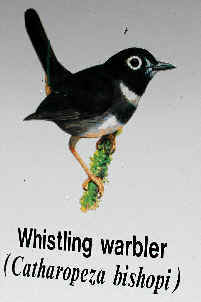
Whistling Warbler
- Oriente Warbler ______ CU
(species endemic to Cuba)
Teretistris fornsi
- Yellow-headed Warbler ______ CU
(species endemic to Cuba)
Teretistris fernandinae
- Ovenbird (*) (ph) ______ BH
CU
CY:dec
DR:feb,mar,apr,dec
JM:mar PR
Seiurus aurocapillus (2 subspecies occur in
the Caribbean: S. a. aurocapillus
& S. a. furvior)
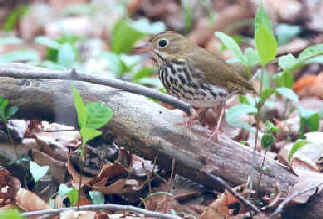
Ovenbird
(photo by Marie Gardner)
-
Northern Waterthrush (*) ______ BH
BU:feb
CU
CY:feb
DM:mar DR:mar,apr JM:mar PR:mar SL
Parkesia (formerly Seiurus)
noveboracensis (now said to be monotypic)
- Louisiana Waterthrush (*) ______ BH
CU
DR:feb JM PR
Parkesia (formerly
Seiurus) motacilla
(monotypic)
- Common Yellowthroat (*) (ph) ______
BH BU:feb CU CY:feb
DR:feb,mar,apr,dec JM:mar,apr PR:mar
Geothlypis t. trichas
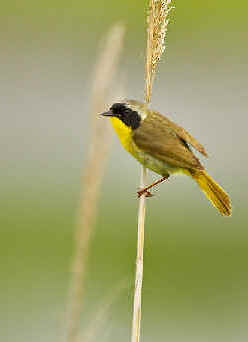
A male Common Yellowthroat
(photo by Kim Steininger)
- Bahama Yellowthroat ______
BH (species endemic to the Bahamas)
Geothlypis rostrata
- Hooded Warbler (*) ______ BH
CU
PR
Setophaga (formerly Wilsonia) citrina
(monotypic)
- Canada Warbler (ph) ______
BD(very rare)
BH(rare) CU(rare)
Cardellina
(formerly Wilsonia) canadensis
A Canada Warbler netted in Barbados on October 31, 1998 was said
to be the first record for that island, and the third for the Lesser
Antilles.
- Wilson's Warbler ______ BH(rare)
CU(rare)
Cardellina
(formerly Wilsonia) pusilla
A Wilson's Warbler was on Grand Bahama Island in February
2001.
- Kentucky Warbler ______ BD(rare)
BH CU PR(rare)
Geothlypis
(formerly Oporornis) formosus
A Kentucky Warbler was in the Maricao Forest in Puerto Rico in
March 1992.
A Kentucky Warbler on Barbados in the fall of 1997 was said to
be the first record of the species for that island.
- Connecticut Warbler (ph) ______ BD(rare)
BH(rare)
CU(rare) DR(rare)
JM(rare)
Oporornis agilis
A juvenile Connecticut Warbler was netted in the southwest Dominican
Republic, at Cabo Rojo near Pedernales, in October 1997, where several
others (not netted) were seen in the same area that month.
A Connecticut Warbler on Barbados in the fall of 1997 was said
to be the first record of the species for that island.
A Connecticut Warbler in Clarendon, Jamaica, on November 29,
2000 was said to be the first record of the species for that
island.
- Mourning Warbler (ph) ______
BH(rare)
CU(rare)
Geothlypis
(formerly Oporornis) philadelphia
- American Redstart (*) (ph) ______
BH CU CY:feb,dec
DM:mar DR:jan,feb,mar,apr,dec JM:mar,apr PR:mar,apr
Setophaga ruticilla (monotypic)
In Jamaica, a local name for the American Redstart is "Butterfly
Bird".
- Semper's Warbler ______ (species
endemic
to St. Lucia)
Leucopeza semperi
The Semper's Warbler may be extinct. The last certain sighting was
in 1961.
- Green-tailed Ground Warbler (*) ______ DR:feb,mar,apr,jul,dec (species
endemic
to Hispaniola)
Microligea palustris (2
subspecies: M. p. palustris
& M. p. vasta)
(the single ember of its genus)
The Green-tailed Ground Warbler has also been called, by
some, the Green-tailed Ground Tanager.
- White-winged Warbler (t3) (*) ______
DR:feb,mar,apr,jul,dec (species
endemic
to Hispaniola)
Xenoligea montana
(monotypic,
and the single member of its genus)
What has been called the White-winged Warbler is also called the Hispaniolan
Highland Tanager.
- Yellow-breasted Chat (ph) ______
BH(rare)
CU(rare)
Icteria virens
BLACKBIRDS & ALLIES
- Shiny Cowbird (*) ______ BD:jul
BH CU DM DR:mar,apr,jul,dec GR JM:mar,apr PR:feb,mar,apr SL:mar,dec
SV:mar,dec
Molothrus bonariensis minimus (this is the subspecies of the West Indies
& the Guianas & adjacent no. Brazil; it's also recently spread into
North America, starting in Florida)
In July 1995, newly-arrived and spreading Shiny Cowbirds were
seen daily near human settlements on North Andros Island in the Bahamas.
- Brown-headed Cowbird (ph) ______
BH
CU(rare)
Molothrus ater
- Greater Antillean Grackle (*) ______
CU CY;feb,jun,dec
DR:feb,mar,apr,jul,dec JM:mar,apr PR:feb,mar,apr
Quiscalus niger bangsi (t3) (subspecies
endemic to Little Cayman island)
Quiscalus niger brachypterus
(subspecies endemic to Puerto Rico)
Quiscalus niger caymanensis (subspecies endemic to Grand Cayman
Island)
Quiscalus niger crassinostris (subspecies
endemic to Jamaica)
Quiscalus n. niger (subspecies, the nominate, endemic to
Hispaniola)
In Jamaica, a local name for the Greater Antillean Grackle is the "Cling-cling".
- Carib Crackle (*) (ph) ______ AT:feb
BD:jul BU:feb DM:jan,feb,mar GD:feb GR SL:mar,dec SV:mar,jul,dec
Quiscalus lugubris (8 subspecies, most of them only on Caribbean
islands)
Quiscalus lugubris contrusus (subspecies endemic to St. Vincent)
Quiscalus lugubris fortirostris (subspecies in Barbados & Antigua)
Quiscalus lugubris guadeloupensis (subspecies on Dominica & other
northern islands of the Lesser Antilles)
Quiscalus lugubris inflexirostris (subspecies endemic to St.
Lucia)
Quiscalus lugubris luminosus (subspecies endemic to Grenada)
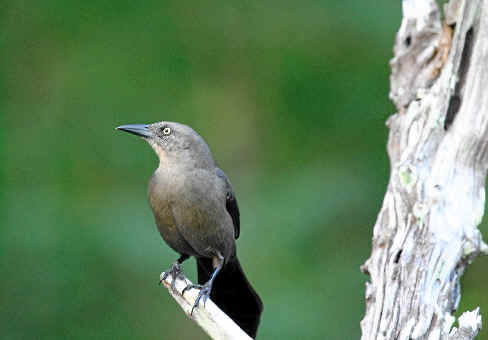
A young male Carib Grackle on the island of Saint Lucia.
A female would have a dark eye.
(photo during the FONT Lesser Antilles Tour in December 2007 by Marie Gardner)
- Great-tailed Grackle (WIr)
______ DR(very rare)
Quiscalus mexicanus
A single Great-tailed Grackle in the Dominican Republic in
December 2007, at Las Calderas de Bani, was said to be the first record of the
species for Hispaniola, and the third record for the West
Indies.
- Puerto Rican Oriole (*) ______ PR;feb,mar,apr
(species endemic
to Puerto Rico) (was known as
Greater Antillean Oriole;
prior to that was
Black-cowled Oriole, when conspecific with the
Central American population that's still called
Black-cowled Oriole, Icterus prosthemelas)
Icterus portoricensis
- Hispaniolan Oriole
(*) ______
DR:feb,mar,apr,jul,dec (species endemic to Hispaniola) (was
known as Greater
Antillean Oriole; prior to that was Black-cowled Oriole,
when conspecific with the Central American population that's still called Black-cowled
Oriole, Icterus prosthemelas)
Icterus dominicensis
- Cuban Oriole ______
CU (species endemic
to Cuba)
Icterus melanopsis
- Bahama Oriole (t1) ______
BH(rare)
(species now endemic to one of the Bahama Islands)
Icterus northropi
The Bahama Oriole is now only on Andros Island with a population
that could be less than 250 individuals. The population on Abaco Island was
extirpated in the early 1990s.
Regarding the BAHAMA ORIOLE, go to: RARE BIRDS OF THE CARIBBEAN
- Jamaican Oriole (*) (ph) ______ JM:mar,apr
(species quasi-endemic to Jamaica)
Icterus l. leucopteryx
(subspecies endemic to Jamaica; another subspecies now on San Andres Island &
one, now extinct, was on Grand Cayman Is.)
A local name for the Jamaican Oriole is "Banana Katie".
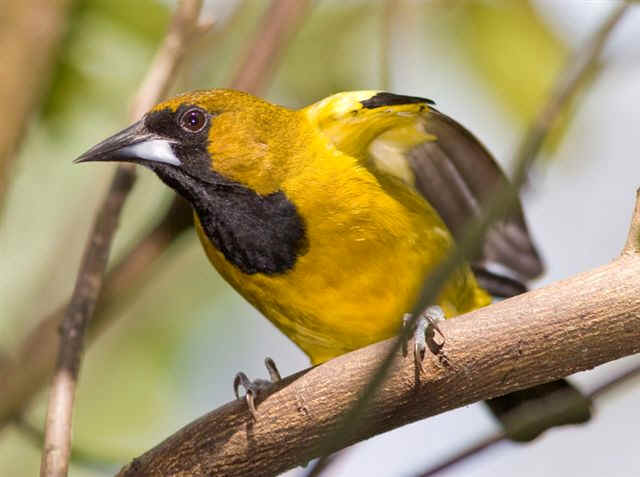
Jamaican Oriole
- Saint Lucia Oriole (nt) (LAe) (*)
______ SL:mar,dec (species
endemic
to St. Lucia)
Icterus laudabilis
(monotypic)
- Baltimore Oriole (*) (ph) ______
BH CU DR(rare) JM:mar
PR
Icterus galbula (monotypic)
The Baltimore Oriole was called the "Northern Oriole"
when it was conspecific with the Bullock's Oriole.
A Baltimore Oriole in the Dominican Republic, near Puerto
Escondido, in April 2009 was said to be the fifth record of the species for
that country.
- Bullock's Oriole (WIr) (ph)
______ BH(very
rare)
Icterus bullockii
A Bullock's Oriole on Grand Bahama Island in February 2001
was said to be the second record of the species for the West Indies.
- Venezuelan Troupial (i) (*) ______ PR:feb,mar,apr
(species native to northern South America)
Icterus icterus
(monotypic)
- Montserrat Oriole (t1) ______
(species endemic to the Lesser Antillean island of Montserrat)
Icterus oberi
- Martinique Oriole (t3) ______
(species endemic to the Lesser Antillean island of Martinique)
Icterus bonana
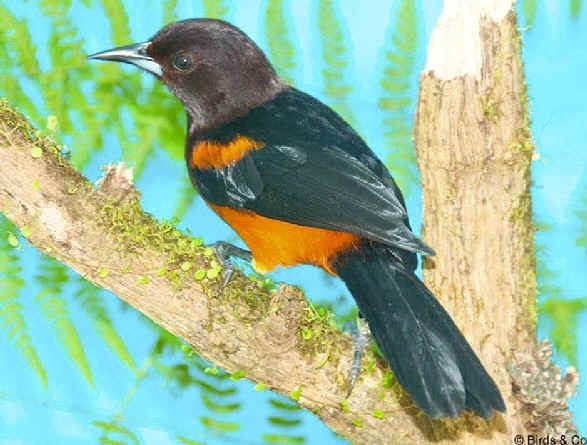
Martinique Oriole
- Orchard Oriole (ph) ______ BH CU(rare)
Icterus spurius
- Hooded Oriole ______
CU(rare)
Icterus cucullatus
- Jamaican Blackbird
(nt) (*)
______ JM:mar,apr (species
endemic
to Jamaica)
Nesopar nigerrimus
(monotypic,
and the single member of its genus)
A local name for the Jamaican Blackbird is the "Wildpine
Sargeant".
- Yellow-shouldered Blackbird (t3) (*) (ph) ______
PR:feb,mar,apr (a
rare species endemic to Puerto Rico)
Agelaius x. xanthomus
(a second PR subspecies on Mona Island)
Regarding the YELLOW-SHOULDERED BLACKBIRD, go to: RARE BIRDS OF
THE CARIBBEAN
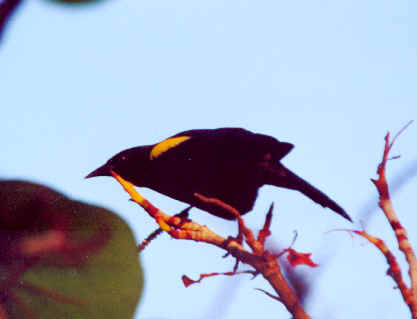
A rare Yellow-shouldered Blackbird photographed during
a FONT tour in Puerto Rico
- Tawny-shouldered Blackbird ______
CU
Agelaius humeralis
- Red-shouldered Blackbird ______
CU (species endemic to Cuba)
Agelaius assimilis
- Red-winged Blackbird (ph) ______
BH
Agelaius phoeniceus
- Cuban Blackbird ______ CU
(species endemic to Cuba)
Dives atroviolacea
- Yellow-headed Blackbird (ph) ______
BH(rare)
CU(rare)
Xanthacephalus xanthacephalus
A female Yellow-headed Blackbird on Abaco Island in September 1998 was
the first record of the species for that island, and was said to be the 4th
record of the species in the Bahamas.
- Eastern Meadowlark (ph) ______
CU
Sturnella magna
- Bobolink (ph) ______
BH CU GR(rare)
Dolichonyx aryzivarus
A flock of as many as about 80 migrating Bobolinks were on
Grenada, at one time in October 2010, in a field at the airport.
BANANAQUIT
- Bananaquit (*) (ph) ______ AT:feb
BD:jul BH
BU:feb CU(rare) CY;feb,jun,dec DM:jan,feb,mar DR:feb,mar,apr,jul,dec
GD:feb JM:mar,apr
PR:feb,mar,apr
SL:mar,dec SV(r)
(these the yellow-breasted subspecies)
Coereba flaveola
(the single member of its genus)
Coereba flaveola bananivora (subspecies endemic to Hispaniola)
Coereba flaveola barbadensis
(subspecies endemic to Barbados)
Coereba flaveola bartholemica (subspecies in Dominica)
Coereba
f. flaveola (subspecies
endemic to Jamaica)
Coereba
flaveola martinicana (subspecies in St. Lucia & Martinique)
Coereba flaveola portoricensis (subspecies endemic to Puerto Rico)
Coereba flaveola sharpei (subspecies endemic to the
Caymans)
In all, there are 41
subspecies of Bananaquit throughout Latin America & the Caribbean. 24 of those
subspecies are on islands in the Caribbean including some off the coasts of
Mexico & Venezuela, & on Trinidad & Tobago.
In Jamaica, a local name for the Bananaquit is "Sugar
Bird".
The Bananaquit is not a common bird in Cuba. A single bird on
the Cayo Paredon Grande, Cuba in the year 2000 was said to be the 20th
Cuban record of the species.

A Bananaquit on the Caribbean island of Saint Lucia
(photographed during the FONT Lesser Antilles Tour in December 2007
by Marie Gardner)
- "Black Bananaquit" (*) (ph) ______ GR
SV:mar,jul,dec (part of Bananaquit)
Coereba flaveola aterrima
(subspecies endemic to Grenada)
Coereba flaveola atrata
(subspecies endemic to St. Vincent)
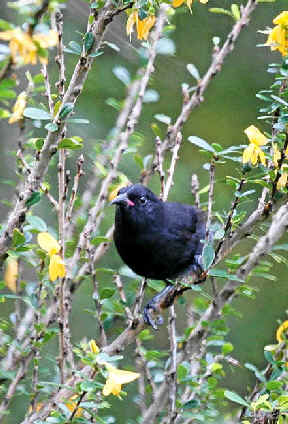
The all-black race of the Bananaquit,
on the Caribbean island of Saint Vincent
(photographed during the FONT Lesser Antilles Tour in December 2007
by Marie Gardner)
SPARROWS, FINCHES, SEEDEATER, GRASSQUITS, BULLFINCHES
- Rufous-collared Sparrow (*) (ph) ______ DR:feb,mar,apr
Zonotrichia capensis antillarum (this subspecies, endemic to the central
highlands of the Dominican Republic, is the only occurrence in the West
Indies of this species wide-ranging in Central & South America;
there is another subspecies in Caribbean on Curacao & Aruba, at
sea-level)
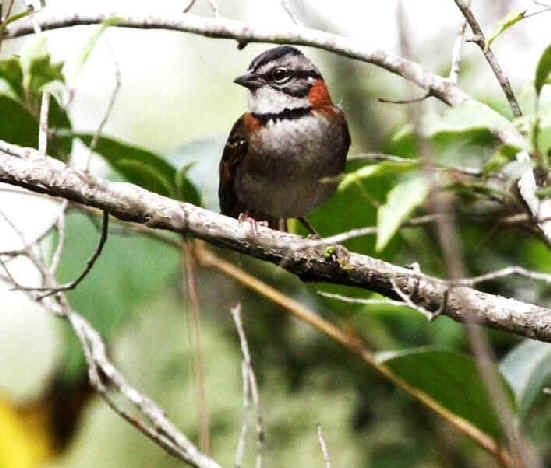
A Rufous-collared Sparrow photographed in the
Dominican Republic
during a FONT tour in February 2012
(photo by Marie Gardner)
- White-crowned
Sparrow (ph) ______ BH CU
Zonotrichia leucophrys
- Lincoln's Sparrow
(*) ______ BH CU JM:feb
Melospiza l. lincolnii
- Swamp Sparrow (ph) ______ BH(rare)
Melospiza georgiana
- Song Sparrow (WIr) (ph)
______ BH(rare)
DR(very rare)
Melospiza melodia
A Song Sparrow was in the Dominican Republic, in the western
Sierra de Neiba near Haiti, in November 1997.
That was thought to be the first record in the West Indies south of the Bahamas,
where there had been 5 sight records.
- Grasshopper Sparrow (ph) ______
BH CU
Ammodramus savannarum
- Lark Sparrow (ph) ______ BH(rare)
CU(rare)
Chondestes grammacus
- Clay-colored Sparrow (ph) ______
BH(rare)
Spizella pallida
A Clay-colored Sparrow was on Grand Bahama Island in February
2001.
- Chipping Sparrow (ph) ______
BH(rare)
CU(rare)
Spizella passerina
- Savannah Sparrow (ph) ______
BH CU
Passerculus sandwichensis
- Dark-eyed Junco (ph) ______
BH(rare) CU(very
rare)
Junco hyemalis
A Dark-eyed Junco on Cayo Guillermo in November 2002 was said to be the
first record of the species for Cuba.
- Zapata (or Cuban) Sparrow
(t2) ______ CU
(species endemic to Cuba)
Torreornis inexpectata
- Saffron Finch (i) (*) (ph) ______
CU(rare)
JM:apr
PR
(species native to southern South America)
Sicalis flaveola
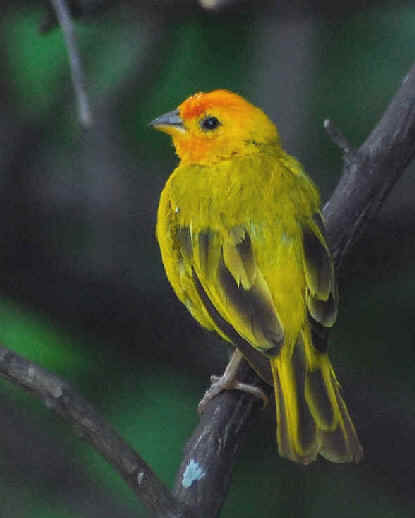
A Saffron Finch photographed in Jamaica in
November 2012
(photo by Suzanne Bradley)
- Grassland Yellow Finch (i) ______
Sicalis luteola
- Yellow-bellied Seedeater (*) ______ GR
(in the Caribbean, only occurs in Grenada, and nearby Carriacou, and
in Trinidad & Tobago)
Sporophila n. nigricollis
- Yellow-shouldered Grassquit (*) ______
JM:mar,apr (species endemic to Jamaica)
Loxipasser anoxanthus
(monotypic, and the single member of its genus)
A local name for the Yellow-shouldered Grassquit is "Yellow-back".
- Yellow-faced Grassquit (*) ______
CU CY:feb,jun,dec
DR:feb,mar,apr,jul JM:mar,apr PR:feb,mar,apr
Tiaris o. olivaceus (subspecies on
Hispaniola, Jamaica, Cuba, & the Caymans)
Tiaris olivaceus bryanti (subspecies endemic to Puerto Rico)
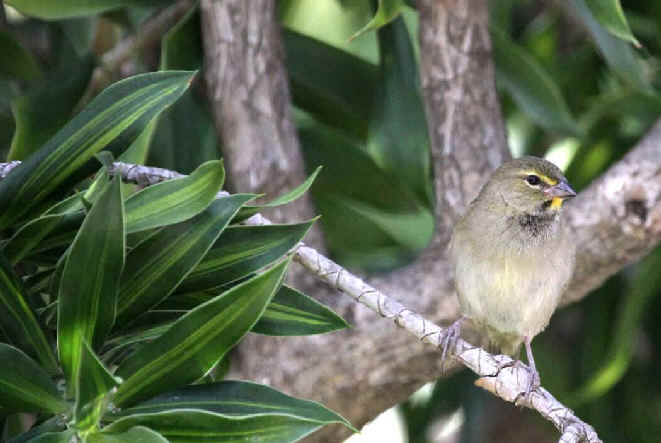
A young male Yellow-faced Grassquit during the
FONT tour
in the Dominican Republic in April 2012
(photo by Marie Gardner)
-
Black-faced Grassquit (*) (ph) ______ AT:feb
BD:jul BH BU:feb
CU
DM:jan,feb,mar DR:feb,apr,dec GD:feb GR JM:mar,apr PR:feb,mar,apr SL:mar,dec SV:mar,jul,dec
Tiaris bicolor marchii (subspecies on
Hispaniola & Jamaica)
Tiaris bicolor omissus (subspecies on
Puerto Rico & in the Lesser Antilles)
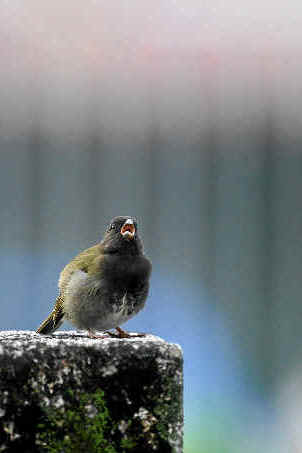
A singing Black-faced Grassquit in an old cemetery
in Kingstown, Saint Vincent
(photo by Marie Gardner during the Dec 2007 FONT Lesser Antilles Tour)
- Cuban Grassquit ______ BH
CU
Tiaris canora
- Blue-black Grassquit (*) ______
GR (in the Caribbean, only occurs in Grenada and in Trinidad &
Tobago)
Volatinia jacarina splendens
- Puerto Rican Bullfinch (*) ______ PR:feb,mar,apr
(species endemic to Puerto Rico)
Loxigilla p. portoricensis
(another subspecies on St Kitts Is. now extirpated)
-
Lesser Antillean Bullfinch (LAqe) (*) (ph) ______ AT:feb
BD:jul BU:feb DM:jan,feb,mar GD:feb PR(rare) SL:mar,dec SV:mar,jul,dec
Loxigilla noctis crissalis (subspecies endemic to St.
Vincent)
Loxigilla noctis dominicana (subspecies in Dominica & Guadeloupe)
Loxigilla noctis sclateri (subspecies endemic to St. Lucia)
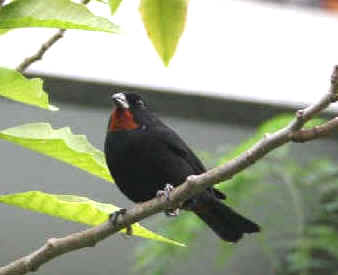
A Lesser Antillean Bullfinch on the island of Saint
Lucia
during the FONT tour in December 2007
(photo by Marie Gardner)
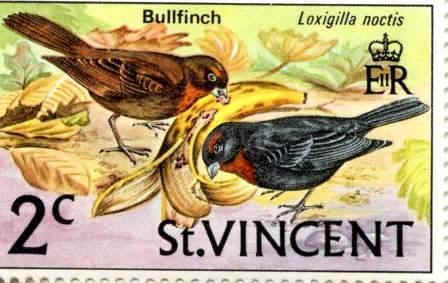
- Barbados Bullfinch (*) _____ BD
(now species endemic to Barbados) (has been part of the Lesser
Antillean Bullfinch)
Loxigilla barbadensis (monotypic)
- Greater Antillean Bullfinch (*) ______
BH DR:feb,mar,apr,jul,dec
JM:mar,apr
Loxigilla violacea affinis
(subspecies endemic to Hispaniola & nearby small offshore islands)
Loxigilla violacea ruficollis
(subspecies endemic to Jamaica)
- Cuban Bullfinch (*) ______ CU
CY:feb,jun,dec
Melopyrrha nigra taylori (subspecies
endemic to Grand Cayman Island) (the species
is the single member of its genus)
- Red-legged Honeycreeper ______ CU
Cyanerpes cyaneus
- Orangequit (*) ______
JM:mar,apr (species endemic to Jamaica)
Euneornis campestris (monotypic,
and the single member of its genus)
- Saint Lucia Black Finch (nt) (LAe) (*)
______ SL:mar,dec (species
endemic
to St. Lucia)
Melanospiza richardsoni (monotypic, and the single member of its genus)
TANAGERS
- Western Spindalis (*) ______
BH CU
CY:feb,jun,dec
(formerly (Western) Stripe-headed Tanager)
Spindalis zena salvini (subspecies
endemic on Grand Cayman Island)
(Other subspecies occur in the Bahamas, Cuba, and Cozumel Is. Mexico;
in all, there are 5 subspecies.)
- Hispaniolan
Spindalis (*) ______ DR:jan,feb,mar,apr,jul,dec
(species endemic to Hispaniola) (formerly
(Hispaniolan) Stripe-headed Tanager)
Spindalis dominicensis (monotypic)
- Jamaican Spindalis (*) (ph) ______ JM:mar,apr
(species endemic to Jamaica)
(formerly (Jamaican) Stripe-headed Tanager)
Spindalis nigricphala (monotypic)
A local name for the Jamaican Spindalis is "Mark
Head".
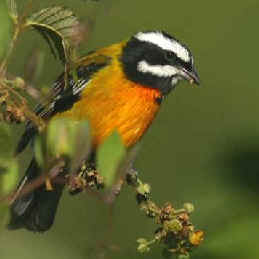
Jamaican Spindalis
- Puerto Rican Spindalis (*) (ph) ______ PR:feb,mar,apr
(species endemic to Puerto Rico)
(formerly (Puerto Rican) Stripe-headed Tanager)
Spindalis portoricensis (monotypic)
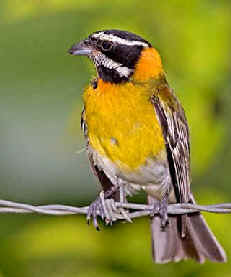
Puerto Rican Spindalis
-
Puerto Rican Tanager (*) ______ PR:feb,mar,apr
(species endemic to Puerto Rico)
Nesospingus speculiferus (monotypic, and the single member of its genus)
- Black-crowned Tanager (*) ______
DR:jan,feb,mar,apr,jul,dec (species
endemic to
Hispaniola) (has been called Black-crowned
Palm-Tanager)
Phaenicophilus palmarum (monotypic)
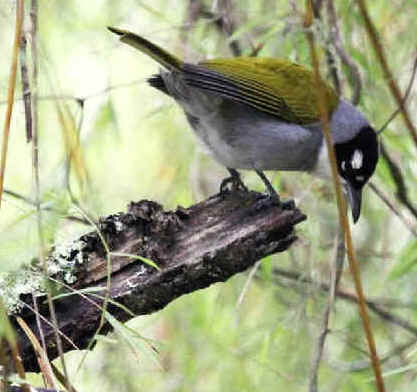
Above & below: a Black-crowned Tanager
during
the FONT Dominican Republic Tour in February 2012.
The local name of the bird is "Cuatro Ojos", or "Four
Eyes".
In the lower photo, it can be seen why.
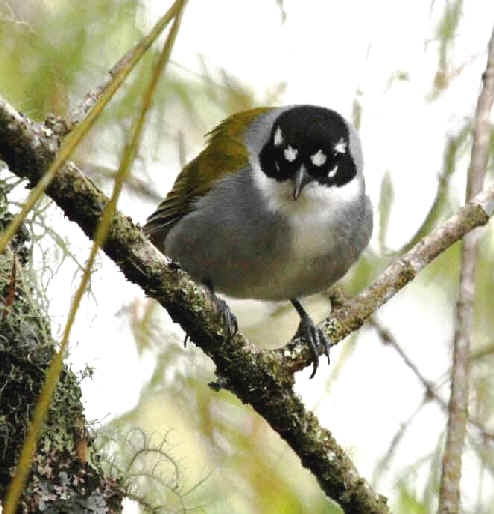
- Gray-crowned Tanager (nt) (*) ______
DR:apr (species endemic to Hispaniola)
(has been called Gray-crowned
Palm-Tanager)
Phaenicophilus p. poliocephalus (1 of 2 Hispaniolan subspecies; the
other on the small offshore Gonave Island; this species mostly in Haiti, rare
in mountains of adjacent Dominican Republic)
- Western Chat-Tanager (t3) (*)
______ DR;feb,mar,apr (species
endemic
to Hispaniola)
Calyptophilus tertius
- Eastern Chat-Tanager (t2) (*) ______
DR:feb (species
endemic
to the Dominican Republic on Hispaniola)
Calyptophilus frugivorus
- Lesser Antillean Tanager (LAe)
(*) ______ SV:mar,jul,dec
(this species restricted to 2 islands, St. Vincent &
Grenada)
Tangara cucullata versicolor (subspecies endemic to St. Vincent)
- Summer Tanager (*) (ph) ______
BH CU
JM:mar
Piranga r. rubra
- Scarlet Tanager (ph) ______
BH CU DR(rare)
SL(rare)
Piranga olivacea
A male Scarlet Tanager in Saint Lucia on April 18, 2000 was
said to be the 6th record of the species on that island.
A Scarlet Tanager in the Dominican Republic in November 2005 was
said to be the first record of the species for that country.
- Dickcissel (ph) ______
BH CU(rare)
Spiza americana
SALTATOR, GROSBEAKS, BUNTINGS
- Lesser Antillean Saltator (LAe) (*) ______
DM:jan,mar GD:feb SL:mar (formerly conspecific with the
Streaked Saltator
of mostly South America)
Saltator albicollis guadelupenis (subspecies
on Dominica &
Guadeloupe)
Saltator a. albicollis (subspecies on St. Lucia & Martinique)
- Rose-breasted Grosbeak (ph) ______
BH
CU DR(rare)
Pheucticus ludovicianus
3 Rose-breasted Grosbeaks were observed in the Dominican Republic,
above Puerto Escondido March 23-24, 1999.
There are very few records of the species for the country.
- Blue Grosbeak (*) (ph) ______ BD(rare)
BH CU
DR:apr JM(rare)
Passerina caerulea
A Blue Grosbeak on Barbados in the fall of 1997 was said to be
the first record of the species for that island.
A Blue Grosbeak in Jamaica, near Stony Hill, in October 2006 was said to be the
first record of the species for that island since 1975.
- Indigo Bunting (*) (ph) ______ BD(rare)
BH
CU
DM:mar(rare)
DR:apr PR:mar
Passerina cyanea (monotypic)
The Indigo Bunting seen during a FONT tour in Dominica in March
2002 was said to be the second record of the species for the island.
An Indigo Bunting on Barbados in the fall of 1997 was said
to be the first record of the species for that island.
- Painted Bunting (ph) ______
BH CU DR(very
rare)
Passerina ciris
A Painted Bunting in the Dominican Republic first
found at Punta Cana in late 2006 was said to be the first record of the
species for the country.
Notes:
Although "A Guide to the Birds of Puerto Rico and the Virgin
Islands", by Herbert A. Raffaele, indicates that there are no records for
the Northern Rough-winged Swallow in Puerto Rico, the species was seen there
during our March 1998 tour in the eastern part of the island. The fore-mentioned
book does say that it has been noted as a rare migrant in the Virgin Islands.
As noted above, the plumages of the Yellow Warbler vary throughout the Lesser Antillean islands. The
males of Dominica & St. Lucia have pale chestnut caps. That of Martinique
has an all-chestnut head.
Most of the Bananaquits on St. Vincent are all-black, Coereba flaveola
atrata.
Also, however, the yellow-bellied race of nearby St. Lucia, Coereba flaveola
martinicana, has also seen during our tours in St. Vincent, along the eastern
coast of the island.
To Top of Page



![]()





















































